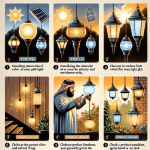Installing Solar Path Lights
Table of Contents
Installing solar path lights is a straightforward and eco-friendly way to enhance the safety, aesthetics, and functionality of outdoor spaces. These lights harness solar energy during the day and automatically illuminate pathways, gardens, and driveways at night, providing a sustainable lighting solution without the need for complex wiring or increased electricity costs. This guide will walk you through the essential steps and considerations for successfully installing solar path lights, ensuring optimal performance and longevity.
Step-by-Step Guide to Installing Solar Path Lights in Your Garden
Installing solar path lights in your garden is a practical and environmentally friendly way to enhance the aesthetic appeal and safety of your outdoor space. The process is relatively straightforward, but it requires careful planning and execution to ensure optimal performance and longevity of the lights. This guide will walk you through the necessary steps to successfully install solar path lights in your garden.
To begin with, it is essential to select the appropriate solar path lights for your garden. Consider factors such as the brightness, design, and durability of the lights. Additionally, ensure that the lights are weather-resistant and suitable for outdoor use. Once you have chosen the right lights, the next step is to determine the layout of your garden path. This involves identifying the areas where you want to install the lights and measuring the distance between each light to ensure even spacing.
After planning the layout, the next step is to prepare the installation site. Start by clearing any debris, rocks, or vegetation from the path where the lights will be installed. This will provide a clean and stable surface for the lights. If necessary, use a garden hose or string to outline the path and mark the spots where each light will be placed. This will help you visualize the final arrangement and make any adjustments before proceeding with the installation.
With the site prepared, it is time to install the solar path lights. Begin by assembling the lights according to the manufacturer’s instructions. This typically involves attaching the solar panel to the light fixture and securing any additional components. Once assembled, insert the stake or base of the light into the ground at the marked spots along the path. Ensure that the solar panel is positioned to receive maximum sunlight during the day, as this will affect the performance of the lights.
After installing the lights, it is important to test them to ensure they are functioning correctly. Most solar path lights have an on/off switch or a mode selector that allows you to choose between different lighting settings. Turn on the lights and check that they illuminate properly. If any lights are not working, double-check the connections and ensure that the solar panel is not obstructed by dirt or debris.
In addition to testing the lights, it is also crucial to maintain them regularly to ensure their longevity. This includes cleaning the solar panels periodically to remove any dust or dirt that may accumulate and hinder their ability to absorb sunlight. Additionally, check the lights for any signs of damage or wear and replace any faulty components as needed.
Finally, it is worth noting that the performance of solar path lights can be influenced by various factors, such as weather conditions and the amount of sunlight they receive. During cloudy or rainy days, the lights may not charge fully and may not provide as much illumination as on sunny days. Therefore, it is important to manage your expectations and understand that the performance of solar path lights may vary depending on the environmental conditions.
In conclusion, installing solar path lights in your garden is a rewarding project that can enhance the beauty and safety of your outdoor space. By carefully selecting the right lights, planning the layout, preparing the installation site, and maintaining the lights regularly, you can enjoy the benefits of solar path lighting for years to come.
Top Tips for Choosing the Best Solar Path Lights for Your Home

When it comes to enhancing the aesthetic appeal and functionality of your outdoor spaces, solar path lights offer an eco-friendly and cost-effective solution. However, selecting the best solar path lights for your home can be a daunting task given the myriad of options available in the market. To make an informed decision, it is essential to consider several key factors that will ensure you choose the most suitable lights for your specific needs.
First and foremost, the brightness of the solar path lights is a critical factor to consider. The brightness of these lights is typically measured in lumens, and it is important to select lights that provide adequate illumination for your pathways. For instance, if you are looking to light up a garden path, lights with a lower lumen output may suffice. Conversely, for driveways or areas requiring more visibility, opting for lights with a higher lumen output would be more appropriate. It is advisable to check the lumen rating on the product specifications to ensure you are getting the desired level of brightness.
In addition to brightness, the battery life and charging time of the solar path lights are crucial aspects to evaluate. Solar path lights rely on sunlight to charge their batteries, and the efficiency of this process can vary significantly between different models. Look for lights that offer a long battery life, ideally lasting through the night after a full day of charging. Moreover, consider the charging time required for the batteries to reach full capacity. Lights with efficient solar panels and high-capacity batteries will provide more reliable performance, especially in areas with limited sunlight.
Durability and weather resistance are also paramount when choosing solar path lights. Since these lights are exposed to the elements, it is essential to select models that are built to withstand various weather conditions, including rain, snow, and extreme temperatures. Look for lights made from high-quality materials such as stainless steel or durable plastic, and ensure they have a high IP (Ingress Protection) rating, which indicates their resistance to dust and water. A higher IP rating will ensure that your lights remain functional and maintain their appearance over time.
Furthermore, the design and style of the solar path lights should complement the overall aesthetic of your outdoor space. Solar path lights come in a wide range of designs, from modern and sleek to classic and ornate. Consider the architectural style of your home and the existing landscape design when selecting the lights. Additionally, think about the placement of the lights and how they will integrate with other outdoor features such as plants, walkways, and garden ornaments. A well-chosen design will not only provide illumination but also enhance the visual appeal of your outdoor areas.
Lastly, it is important to consider the ease of installation and maintenance of the solar path lights. Opt for lights that come with clear instructions and require minimal tools for installation. Some models offer features such as adjustable height and angle, which can provide greater flexibility in positioning the lights for optimal performance. Additionally, consider the maintenance requirements, such as cleaning the solar panels and replacing batteries. Choosing lights with low maintenance needs will save you time and effort in the long run.
In conclusion, selecting the best solar path lights for your home involves careful consideration of factors such as brightness, battery life, durability, design, and ease of installation. By taking these aspects into account, you can ensure that you choose lights that not only meet your functional needs but also enhance the beauty and ambiance of your outdoor spaces.
Common Mistakes to Avoid When Installing Solar Path Lights
Installing solar path lights can be a straightforward and rewarding project, enhancing both the aesthetic appeal and safety of your outdoor spaces. However, there are several common mistakes that homeowners often make during the installation process. By being aware of these pitfalls, you can ensure a more efficient and effective setup, ultimately leading to better performance and longevity of your solar path lights.
One of the most frequent errors is neglecting to properly position the solar panels. Solar path lights rely on sunlight to charge their batteries, so it is crucial to place them in areas that receive ample sunlight throughout the day. Avoid installing the lights in shaded areas or under trees, as this will significantly reduce their ability to charge and function optimally. Instead, choose locations that are exposed to direct sunlight for the majority of the day. Additionally, be mindful of seasonal changes and the shifting position of the sun, which can affect the amount of sunlight your solar panels receive.
Another common mistake is failing to prepare the installation site adequately. Before placing the lights, ensure that the ground is level and free of debris. Uneven terrain can cause the lights to tilt or become unstable, leading to poor illumination and potential damage. It is also advisable to test the lights in their intended locations before permanently installing them. This allows you to assess the light distribution and make any necessary adjustments to achieve the desired effect.
Improper spacing of the lights is another issue that can compromise the effectiveness of your solar path lighting. Placing the lights too close together can create an overly bright and cluttered appearance, while spacing them too far apart can result in uneven lighting and dark spots along the path. A general rule of thumb is to space the lights approximately six to eight feet apart, but this can vary depending on the specific design and layout of your outdoor area. Experiment with different spacing options to find the optimal arrangement for your needs.
In addition to positioning and spacing, it is important to consider the quality of the solar path lights themselves. Investing in high-quality lights with durable materials and efficient solar panels can make a significant difference in performance and longevity. Cheaper, lower-quality lights may be more prone to damage and may not provide consistent illumination. Look for lights with weather-resistant features and reliable battery life to ensure they can withstand various environmental conditions and provide consistent performance over time.
Another mistake to avoid is neglecting regular maintenance of your solar path lights. Over time, dirt, dust, and debris can accumulate on the solar panels, reducing their ability to absorb sunlight. Periodically cleaning the panels with a soft cloth and mild detergent can help maintain their efficiency. Additionally, check the lights for any signs of damage or wear, such as cracked casings or corroded connections, and address any issues promptly to prevent further deterioration.
Lastly, be mindful of the overall design and integration of your solar path lights within your outdoor space. Consider the style and color of the lights to ensure they complement your existing landscape and architectural features. Thoughtful placement and design can enhance the visual appeal of your outdoor area while providing functional illumination.
By avoiding these common mistakes, you can ensure a successful installation of your solar path lights, resulting in a beautifully illuminated and safe outdoor environment. Taking the time to plan and execute the installation carefully will pay off in the long run, providing you with reliable and aesthetically pleasing lighting for years to come.
Read more about Solar Path Lights:
- Benefits of Solar Path Lights
- How to Choose the Right Solar Path Lights
- Maintaining Solar Path Lights
- Creative Ways to Use Solar Path Lights in Your Outdoor Space
- Solar Path Lights vs Traditional Outdoor Lighting
- Troubleshooting Common Issues with Solar Path Lights
- Maximizing the Lifespan of Solar Path Lights
- Solar Path Lights for Commercial Use
- Solar Path Lights in Different Climates and Locations







